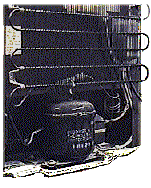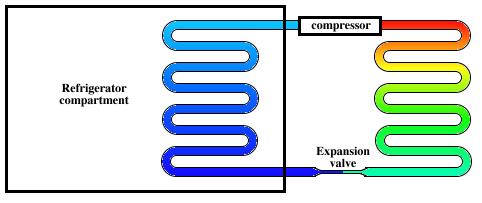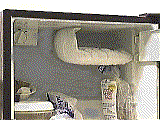 |
 |
 |
 "What is Physics Good For?"
"What is Physics Good For?"
Extra credit is available at the end of this page. Please respond before 9 AM, Monday, September 18th, 2000.
The central element in the operation of a refrigerator (or a freezer) is a fluid, called a refrigerant or, occasionally, a working fluid. Of course, some refrigerants work better than others. The most efficient refrigerants that have been found to date belong to the Freon family which includes CCl2F2 (FREON-12), CClF3 (FREON-13), and many others. These materials are known as chloroflorocarbons (CFC's). Unfortunately, it has recently become apparent that these chemicals damage the Earth's ozone layer.
To see how this works we start by looking into this "circuit". The basic parts are a compressor, the condenser coils, the expansion valve and the refrigerant. We begin with the refrigerant in the gaseous state as it leaves the cooler interior of the 'fridge. A compressor, using energy from the wall outlet, compresses the gas adiabatically. This raises its temperature and forces it into the condensing coils (located on the back of most refrigerators). For an adiabatic process, the change in temperature can be calculated using
 -1 -1
where T1 and V1 are the initial temperature and pressure, and T2, V2 are the final temperature and pressure.
As the compressed gas moves into the condenser coils its temperature is higher than that of the surrounding air (i.e. your kitchen). Thus, heat will flow out of the refrigerant and be taken away by the air. (This is the step in which running the 'fridge heats the kitchen). As the name suggests, the refrigerant is condensed during this process, so it is in its liquid state as it moves on the next stage. The liquid is forced back into the refrigerator through an expansion valve. Here, a rapid drop in pressure cools the refrigerant and allows it to return to the gaseous state.
Now, the temperature of the refrigerant is lower than that of the interior of the
refrigerator. Heat will flow from the air inside the compartment
into the much cooler substance flowing through the coil. Finally, the "circuit" is closed; the refrigerant enters the compressor again.
This process shows the importance of choosing the proper refrigerant
for the job: it must be able to maintain a liquid state while
dropping to temperatures much lower than the freezing point of
water. FREON-12 (the refrigerant used most commonly from the Freon
family) has a freezing temperature of -158°C. It must also have a boiling point somewhat below room temperature and a heat of vaporization low enough to allow the partial phase change to occur in the expansion valve. It must also have low toxicity (since they may accidentally be released in the home or car) and it must have a low viscosity in order to move freely through the system.
You can get a lot more information about this subject on the internet. Here are a few search enginesAnd here are a few good links to get you started. Research Questions (1 point extra credit each!)
This site is made possible by funding from the National Science Foundation (DUE-9981111). |
 Keeping things cool is one of the basic needs in our society. Keeping ourselves cool in summer allows us to be more productive, keeping our food cool allows us to store it longer and to enjoy foods grown in other parts of the world. Furthermore, many important medicines must be kept cool. Relief agencies must keep careful track of the availability of refrigerators and refrigerated trucks in order to ensure that medical supplies can reach remote parts of world intact. This system is known as a
Keeping things cool is one of the basic needs in our society. Keeping ourselves cool in summer allows us to be more productive, keeping our food cool allows us to store it longer and to enjoy foods grown in other parts of the world. Furthermore, many important medicines must be kept cool. Relief agencies must keep careful track of the availability of refrigerators and refrigerated trucks in order to ensure that medical supplies can reach remote parts of world intact. This system is known as a  In a refrigerator (or air conditioner) the refrigerant forms the "circuit" that allows heat to be "pumped" from the cooler region (inside of the 'fridge) to the warmer region (the kitchen).
In a refrigerator (or air conditioner) the refrigerant forms the "circuit" that allows heat to be "pumped" from the cooler region (inside of the 'fridge) to the warmer region (the kitchen).


 As we mentioned above the members of the Freon family
do damage the ozone layer in the Earth's upper atmosphere; so why don't we find another refrigerant that can do the same job without damaging the environment?
The effort to accomplish this is ongoing, and viable alternatives have been found for many applications. However, many others have been rejected either because the do not provide enough cooling capacity or because their environmental effects are as bad or worse than those of Freon.
A few refrigerants, such as R-409A and EC-12a, have been approved
by the EPA (Environmental Protection Agency), and although not
as efficient as CFC-12 and its brethren, do not pose such a long
term threat to the world in which we live.
As we mentioned above the members of the Freon family
do damage the ozone layer in the Earth's upper atmosphere; so why don't we find another refrigerant that can do the same job without damaging the environment?
The effort to accomplish this is ongoing, and viable alternatives have been found for many applications. However, many others have been rejected either because the do not provide enough cooling capacity or because their environmental effects are as bad or worse than those of Freon.
A few refrigerants, such as R-409A and EC-12a, have been approved
by the EPA (Environmental Protection Agency), and although not
as efficient as CFC-12 and its brethren, do not pose such a long
term threat to the world in which we live.